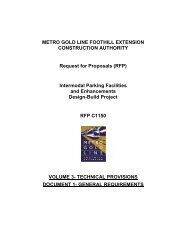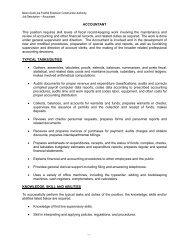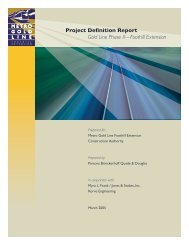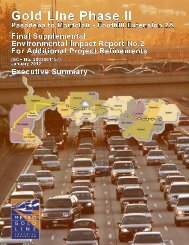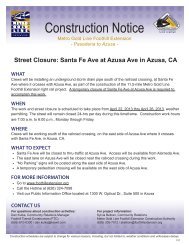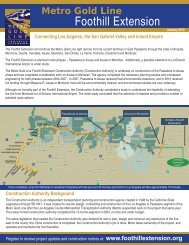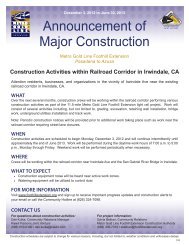Part 3 - Metro Gold Line Foothill Extension
Part 3 - Metro Gold Line Foothill Extension
Part 3 - Metro Gold Line Foothill Extension
Create successful ePaper yourself
Turn your PDF publications into a flip-book with our unique Google optimized e-Paper software.
Noise and Vibration Technical Report: <strong>Metro</strong> <strong>Gold</strong> <strong>Line</strong> <strong>Foothill</strong> <strong>Extension</strong>, Azusa to Montclair<br />
July 2012<br />
Page 82<br />
Source: ATS Consulting, 2011<br />
Notes:<br />
Heights and lengths of the sound walls are subject to design refinements. Heights may be significantly altered if<br />
quiet zones waivers are granted for at-grade crossings.<br />
1<br />
EB = towards Montclair (south side of tracks); WB = towards Azusa (north side of tracks)<br />
2<br />
Height above the top-of-rail<br />
Sound walls must stop at intersections, reducing their effectiveness at grade crossings because of noise<br />
leaks around the ends of the walls. In addition, it is not feasible or cost effective for noise barriers to<br />
protect some second floors of noise-sensitive receivers. The recommended mitigation measure in these<br />
instances is sound insulation of the building. Table 34 indicates the locations where sound insulation for<br />
second stories is recommended. Sound insulation is recommended for all second-story windows facing<br />
the tracks within the cluster identified.<br />
Table 35 indicates the locations where sound insulation is recommended for sensitive receivers near atgrade<br />
crossings Improved sound insulation for windows and doors that would be affected by the “sound<br />
leak” around the ends of sound barriers at intersections is one mitigation approach. An alternative<br />
approach for noise mitigation at a grade-crossing is to use transparent panels for the sound wall. This<br />
approach has been used on Phase 1 of the Exposition Corridor project to mitigate noise impacts with a<br />
barrier while maintaining a visual line of sight.<br />
Policies for the implementation of residential sound insulation can be based on policies that have been<br />
used by other transit systems including TriMet in Portland, Oregon and Sound Transit in Seattle. The<br />
approach in Portland and Seattle is to consider sound insulation for residences where the interior noise<br />
levels exceed the US Department of Housing and Urban Development (HUD) maximum allowable<br />
interior noise level of 45 dBA Ldn and the improvements will result in at least 5 decibels of noise<br />
reduction. The implementation of the policy would include indoor noise testing and analysis to determine<br />
the appropriate improvements for each residence. However, implementation of sound insulation requires<br />
permission of property owners to allow access to the interior of their properties for both noise<br />
measurements and improvements.<br />
Table 34: Recommended Locations for Sound Insulation of<br />
Second Stories<br />
City<br />
Cluster<br />
Glendora WB 4<br />
Glendora WB 6<br />
Glendora WB 9<br />
Glendora WB 10<br />
Glendora WB 20<br />
Glendora EB 1<br />
Glendora EB 3<br />
Glendora EB 4<br />
Glendora EB 7




